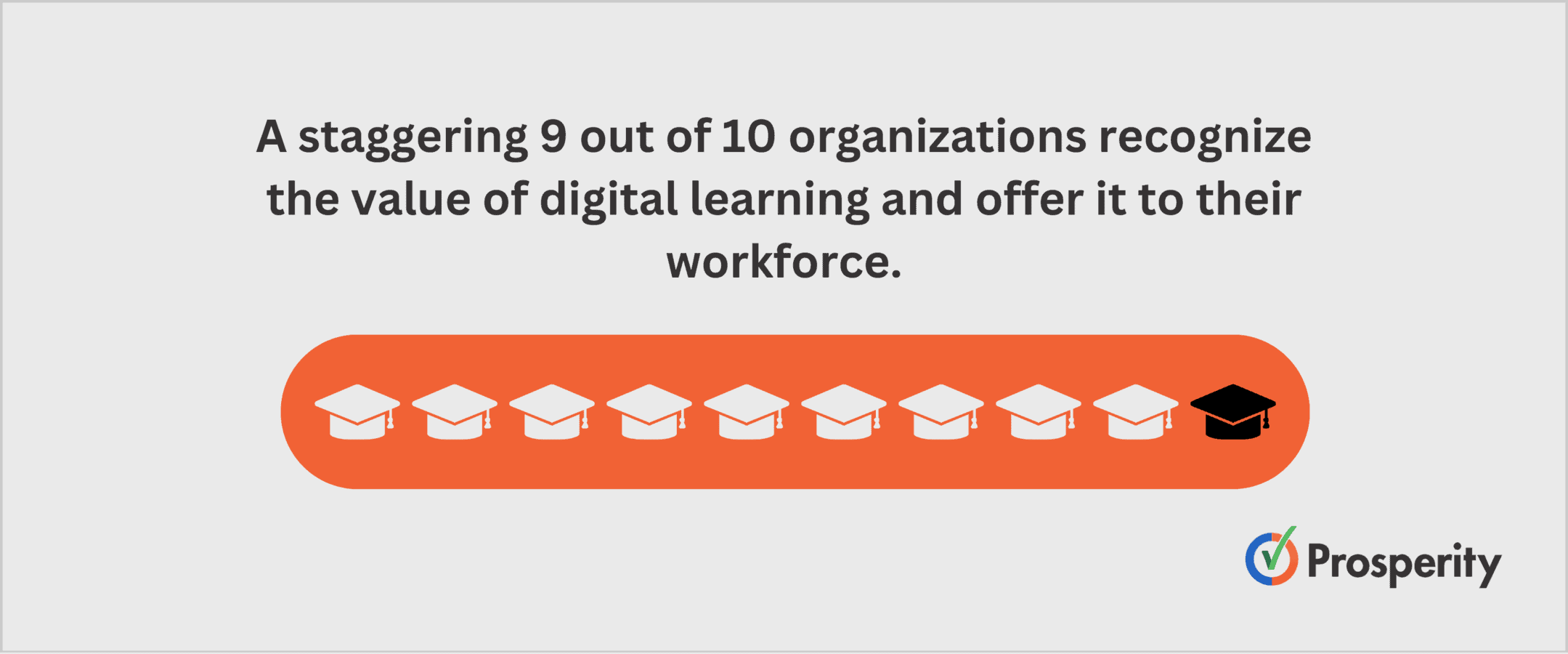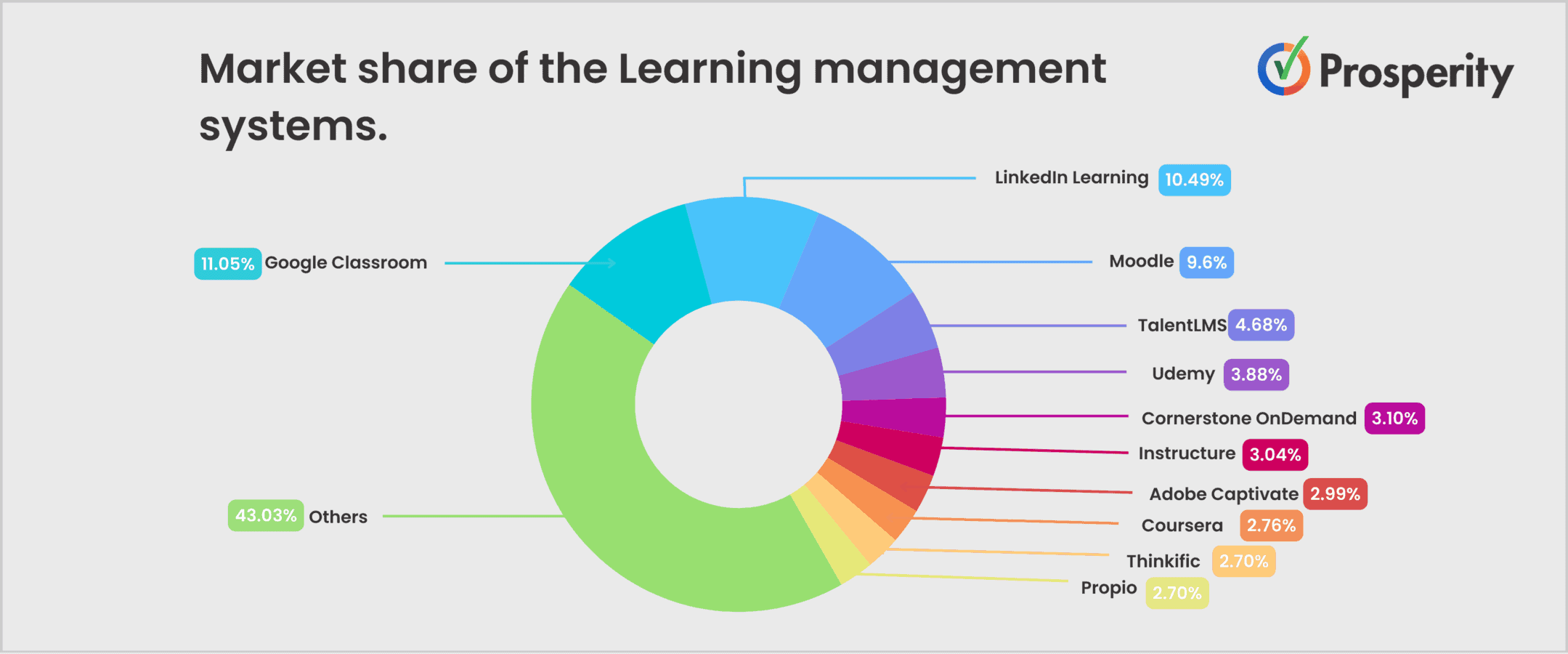From corporate giants to individual learners, eLearning has transformed how people acquire knowledge.
The eLearning space has grown by more than 9% in the past two decades. It is further expected to grow and acquire a large share of the educational industry.
Let’s take a closer look at the e-learning market, its users, effectiveness, and more.
Top eLearning Statistics 2024
- The eLearning market is forecasted to surpass $185.20 billion by 2024.
- Over 60% of students in the United States use eLearning daily.
- 73% of US students wish to continue taking online classes after the pandemic period.
- Online learning has grown by over 900% since 2000.
- 90% of companies provide some form of online training to their staff members.
- 40% of Fortune 500 companies are using eLearning
- eLearning can reduce the learning time by 40% to 60%
- Learners retain up to 60% more through online courses.
eLearning Market Statistics
The eLearning market has skyrocketed during the Covid-19 pandemic. With the shift in the learning landscape worldwide, the e-learning market and its revenue grew rapidly.
Here are the details about the value of the eLearning market, its growth, and the related predictions.
The eLearning Market Is Estimated To Reach $185.20 Billion In 2024
The e-learning market is projected to grow by 8.61% annually, reaching $257.70 billion between 2024 – 2028.
Some major factors that affect the growth of the e-learning market are increased demand for digital skills, the rise of online degree programs, increased adoption of technological devices, flexibility, cost efficiency, accessibility, and more.
Source: Statista.
The US eLearning Market Is Estimated To Increase By $56.44 Billion Between 2023 And 2028
The market is estimated to grow at a CAGR of 16.48% in the forecast period.
The online learning and education landscape in the United States has grown from $25.48 billion in 2018 to around $35 billion in 2023. That’s an increase of approximately $10 billion in the e-learning market size in just 5 years.
Source: Technavio.
The Mobile Learning Market Size Is Anticipated To Reach $88.12 Billion In 2024
The mobile learning market was valued at $68.36 billion in 2023 and is projected to reach $88.12 billion in 2024. That’s a CAGR of 28.9% in just a year.
The market is further projected to reach $254.52 billion in 2028, growing at a CAGR of 30.4% between the forecast period of 2024 and 2028.
Source: The Business Research Company.
Growth of Online Learning
Online learning has grown by 900% since 2000.
With the increased demand for online learning, the market has grown rapidly since its launch.
The number of users in the online learning platform market is expected to reach 1 billion by the end of 2028.
Countries like the United States are advancing its adoption and usage. Meanwhile, the major markets include India, China, the Philippines, and Thailand, with a more than 30% annual growth rate.
Source: Oxford College, Devilpeck, Statista.
eLearning Schools And Students Statistics
The widespread adoption of eLearning during the pandemic has brought major changes in the way students perceive learning today. Online learning has made the process more engaging and reduced the time required to understand the concepts.
This section will take you through the usage of eLearning by students and teachers, along with their perceptions about eLearning.
30% Of All Postsecondary Degree Seekers In The United States Studied Exclusively Online In 2021
Meanwhile, 60% of the postsecondary degree seekers were enrolled in at least some online classes.
Source: Forbes
70% Of Students Say Online Learning Is Better Than Traditional Classroom Learning
Additionally, 77% of educators believe that online learning is just as good as traditional learning, if not better.

Source: University of the POTOMAC.
8.5 Million Students Have Enrolled In Online Courses In Public Colleges In 2021
Meanwhile, 2.7 million enrolled as online learners in private schools. Of these, 1.9 million attended nonprofit institutions, and nearly 800,000 attended for-profit schools.
Source: Forbes.
73% Of US Students Wanted To Continue Taking Online Classes After The Pandemic
In a survey conducted in 2021, nearly three-fourths of the students said they would take some classes online after the pandemic.
At the same time, more than half of the students were very optimistic about online learning and use of digital materials.

Meanwhile, 68% of the students preferred a combination of in-person and online courses.
Source: Campus Technology.
57% Of The K 12 Students In The United States Used Digital Learning Tools Daily In 2019
Over 63% of high school students and 45% of elementary school students in the country use online learning daily.
Plus, 64% of middle school students use digital learning tools daily.
Seeing the digital transformation in learning, the percentage of digital learning tools might have drastically increased from 2019 to 2024 (yet to be disclosed).
Source: Statista.
Corporate eLearning Statistics
eLearning has been a boon not just for the education Industry but also for corporate companies. Nearly half of the Fortune 500 companies use eLearning to upskill their employees.
This leads to a decrease in error and increased quality of work. Here are further details about the usage of eLearning by the corporate industry.
The Corporate eLearning Market Is Forecasted To Reach $44.6 Billion By 2028
The market is predicted to be growing at a CAGR of 10.5% between 2022 and 2028. In 2021, the market was valued at $22.5 billion.
Source: PR Newswire.
40% Of The Fortune 500 Companies Use Elearning Regularly
IBM reported saving $200 million after switching employee training to eLearning using technology-based distance learning.

The study further revealed that investing in employees gives higher ROI. Every dollar invested in online training resulted in $30 in productivity.
Source: Luisa Zhou, Washington Post.
90% Of Companies Offer Digital Learning Opportunities Today
93% of the learners stated that online resources improved their learning experience.

In a survey, 68% of the employees reported that they prefer to learn at work than after work, while 58% said they would prefer to learn at their speed.
On the other hand, 49% said they prefer to learn only when necessary.
Source: Teachfloor, LearnNow.
76% Of Employees Are Likelier To Stay With A Company That Offers Continuous Training
Over 80% of hiring managers believe employee training is beneficial to attract and select the right candidates. Additionally, 86% say that training is critical for the retention of employees.
Source: Delvin Peck.
MOOC Statistics
MOOCs are free to anyone who can access them. Most of the eLearning platforms, like Coursera, Udemy, etc, are MOOCs as well as LMS.
Here are further details about the MOOCs.
The Global MOOC Market Is Valued At $22.8 billion As Of 2024
The market is predicted to reach $119.17 billion in 2029, growing at a CAGR of 39.20%.
Asia-Pacific is the fastest-growing MOOC market, while the largest market is North America.
Source: Mordor Intelligence.
The Average Completion Rate For MOOCs Is Between 3% To 6%
The average rate of online course completion is between 5 to 15 percent. Unfortunately, most MOOCs struggle with low completion rates, with only 3-6% of enrollees finishing the course.

Most online learners lose focus in self-paced online courses and cannot acquire full-impact knowledge.
However, the completion rates for some courses may exceed 40%.
Source: Research Gate.
Udemy Has 64 Million Learners As Of June 2023
There are more than 210,000 courses on the platform in nearly 75 languages. Over 870 million course enrollments are recorded on the platform.
Further, the number of instructors on the platform is more than 75,000.
Source: Wikipedia.
Coursera Has 129 Million Registered Learners
Coursera is one of the largest online learning platforms worldwide, with more than 6,900 courses, professional certificates, and degrees from top universities and companies worldwide.

The platform generated total revenue of $635.8 million in 2023. This was an increase of 21% compared to the previous year.
Source: Coursera, Coursera Financial Results.
More Than 81 Million People Worldwide Use Edx
In 2023, EdX had more than 110 million global users. This was an increase of 29 million from 2019.
Source: edX.
Learning Management System(LMS) Statistics
LMS are the software applications that centralize and streamline the process of learning and tracking progress. They support interactive learning methods like quizzes, simulations, games, and discussions.
Let’s take a detailed look at the latest statistics related to LMS in this section.
73.8 Million People Worldwide Are estimated To Use LMS
The primary users of LMS are corporate-level executives and managers, with a share of 65% and 35%, respectively.

Globally, the long-established tech companies account for 30% of the LMS users, while the education industry accounts for 21%.
Source: Research.com.
The Global LMS Market Is Anticipated To Reach $47.47 Billion By 2030
In 2023, the market size of learning management systems was estimated to be $18.26 billion, showing an increase of almost 2 billion compared to 2022 – $16.19 billion.
The market is expected to grow at a CAGR of 14.6% between 2023 to 2030.
Source: Fortune Business Insights.
85% Of Faculty Use A Learning Management System (LMS)
Of these, 56% of the faculties use it daily. Almost 99% of colleges and universities are projected to run an LMS.
74% of the faculties further stated that LMS is a useful tool to enhance teaching.
On the other hand, 83% of the students use LMS, and 56% stated that they use it for almost all courses.
Source: Educause Review.
Google Classroom Dominates The LMS Market With 11.05% Of The Market Share
It is followed by LinkedIn Learning, with a market share of 10.49%.
LinkedIn learning is one of the most used LMS by corporates as well as individuals. The courses help the learners to upscale their careers and skills.
Besides, Udemy ranks 5th with 3.88% of the market share. Coursera holds just 2.76% of the LMS market.

Here are further details about the market share of the Learning management systems.
| Learning Management Systems | Market Share |
|---|---|
| Google Classroom | 11.05% |
| LinkedIn Learning | 10.49% |
| Moodle | 9.58% |
| TalentLMS | 4.68% |
| Udemy | 3.88% |
| Cornerstone OnDemand | 3.10% |
| Instructure | 3.04% |
| Adobe Captivate | 2.99% |
| Coursera | 2.76% |
| Thinkific | 2.70% |
| Propio | 2.70% |
| Others | 43.03% |
Source: 6sense.
Benefits Of eLearning
Since there are plenty of benefits to e-learning, most organizations have adopted this learning method.
Let’s look into the benefits of e-learning in detail.
Students Retain 25% to 60% More Through Online Courses
Comparatively, they retain just 8% to 10% in a classroom. Furthermore, online learning saves 40% to 80% of the time required to teach students.

This is because they have more control over the learning process compared to that in the offline learning. Plus, they are able to learn five times more without increasing the time spent on learning.
Source: Luisa Zhou, UCF Online.
Online Courses Have A Completion Rate Of 12% To 15%
On the other hand, traditional classes have a completion rate of just 4% to 9%.
The average completion rate for online courses varies according to the course type, learning platform, and how the completion rate is defined. Some courses have a completion rate of as high as 40%.
Source: Sell course online, Teachfloor.
ELearning Boasts A 72% Success Rate
This increased success rate is due to higher retention rates and less study time.
Plus, 81% of US college students feel e-learning improved their academics, and 40% find e-learning more efficient and precise than traditional teaching.
Source: G2 Learn Hub.
Elearning Can Reduce The Learning Time By 40% To 60%
While learning online, students learn at their own pace and according to the amount of information they can grab.
They can immediately replay the concepts that they learned, and as a result, the learning time is reduced by almost 50%.
Source: Devlin Peak.
Challenges Of eLearning
While eLearning has many benefits, it also has a flip side. Let’s check out the challenges the learners face while learning online.
78% Of The Students Think That It Is Easier To Learn Inside Of A Classroom
In a survey of 1000 students, 4 in 5 stated that an offline class was more engaging and easier to learn and understand.
Many younger students prefer learning in the classroom over learning online.
Source: Luisa Zhou.
Only 18% Of The Public Schools Agreed That The Teachers Are Trained Sufficiently For Online Teaching In The Academic Year 2019-2020
Online teaching can be difficult as teachers must learn to use various technologies to make their classes more engaging and interactive.
However, most of the teachers are not aware of the latest technology and tools and require training for it. In fact, 56% of the teachers lack confidence in using technology.
AI In eLearning
The AI in the eLearning market is projected to grow by over 10% between 2023 and 2032
The market was valued at $4 billion in 2022.

Further, AI is projected to be adopted by around 47% of LMS platforms by the end of 2024.
This would empower the learning and development (L&D) teams to train the staff better and automate the error-prone and tedious administrative tasks.
Source: DDI Development, Training Industry.
eLearning Case Studies
eLearning has brought a vast increase in the growth of the organizations that have adopted its usage. Educational institutes, corporates, and businesses have been positively impacted by the adoption of elearning.
Let’s take a look at how elearning adoption has benefited different organizations through some case studies.
Elearning Helped Ryman Healthcare Increase Its Teams’ Knowledge Retention Up to 90%
Ryman Healthcare was able to move from paper training to smartphone training in less than a month. eLearning and mobile training helped the healthcare teams retain more information.
This also led to a 100% increase in the participation rates of the teams.
93% of the workforce found that they learned something new in their mobile training sessions compared to the old corporate training format.
Source: EdApp.
Merck & Co. Inc. Witnessed A 97% Decrease In Errors After Providing Online Training To The Workforce
Merck aimed to transition from the standard click-through eLearning methods commonly used in compliance training. Hence, they used online simulations to train their workforce and to provide real-life experiences.
After implementing eLearning, their training process became 15 times quicker with the help of simulations compared to traditional instructions.
The company also noticed a 21% increase in learners’ skills and performance and a 97% decrease in errors.
Further, at the end of the training, 91% of the participants confirmed that the simulations and the online training were a valuable use of their time.
Source: eLearning Case studies.
eLearning has indeed paved its way in the education industry and has been widely adopted by educational and corporate organizations worldwide. It will be interesting to see how the addition of AI and VR impacts the eLearning in the upcoming years.
That’s all about the eLearning Industry from my side. Here are some related reads you can check out.
- How Online Learning Affects Students
- How Online Learning Platforms Track Learners?
- How Much is LinkedIn Learning
- CFI Discount Code (April 2024) – 40% OFF Coupon - April 3, 2024
- 25% Grammarly Student Discount (April 2024) - March 28, 2024
- College Dropout Rates 2023-24(Demographic Stats) - March 20, 2024


